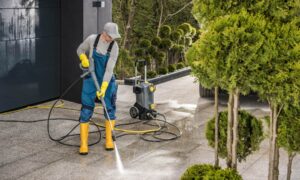Pest control is a crucial aspect of maintaining a healthy and safe living environment. Various pests, including insects, rodents, and other organisms, can pose significant health risks, cause structural damage to properties, and create general discomfort. Understanding the different pest control services available, their importance, and the methods used can help homeowners and businesses effectively manage and prevent infestations.
Importance of Pest Control
Pest control is essential for several reasons:
- Health Protection: Pests like rodents, mosquitoes, and cockroaches can carry diseases and bacteria that can lead to serious health issues. For example, rodents can spread hantavirus, leptospirosis, and salmonella, while mosquitoes are known carriers of malaria, dengue fever, and the Zika virus. Regular pest control can significantly reduce these health risks.
- Property Protection: Termites, carpenter ants, and other wood-destroying pests can cause extensive damage to buildings and structures. This damage can be costly to repair and may compromise the structural integrity of a property.
- Food Safety: Pests can contaminate food supplies, leading to foodborne illnesses. This is particularly important in restaurants, food processing plants, and other establishments where food safety is critical.
- Comfort and Peace of Mind: Living in a pest-free environment is more comfortable and less stressful. Pests can cause allergies, asthma, and other health issues, making it difficult to relax and enjoy your home or workspace.
Types of Pest Control Services
There are various pest control services Fort Myers available, each designed to target specific pests and prevent infestations. The most common services include:
- General Pest Control: This service covers a broad range of common household pests, such as ants, cockroaches, spiders, and more. It typically involves regular inspections, treatments, and preventive measures to keep pests at bay.
- Termite Control: Termite control focuses on identifying, treating, and preventing termite infestations. This service often includes termite inspections, baiting systems, and soil treatments to protect the property from these destructive pests.
- Rodent Control: Rodent control involves the removal and prevention of mice and rats. This service includes identifying entry points, setting traps, and using rodenticides to eliminate infestations.
- Mosquito Control: Mosquito control services aim to reduce mosquito populations and prevent the spread of mosquito-borne diseases. This can include treatments such as fogging, larvicides, and the elimination of standing water sources where mosquitoes breed.
- Lawn Services: Pest control can also extend to lawn care, where services target pests that affect lawns and gardens. This includes treatments for grubs, beetles, and other insects that can damage grass and plants.
Methods of Pest Control
Pest control methods can be broadly categorized into chemical, biological, and mechanical approaches. Each method has its advantages and is used depending on the type of pest and the severity of the infestation.
- Chemical Methods:
-
-
- Insecticides: These are chemicals specifically designed to kill or repel insects. They can be applied as sprays, baits, or dusts.
- Rodenticides: These are chemicals used to kill rodents. They are typically used in bait stations to attract and eliminate mice and rats.
- Fumigants: These are gases used to fumigate and eliminate pests from enclosed spaces. This method is often used for severe infestations and requires the property to be vacated during treatment.
-
- Biological Methods:
-
-
- Natural Predators: Introducing natural predators of pests, such as ladybugs for aphids or nematodes for grubs, can help control pest populations.
- Pathogens: Using pathogens like bacteria, fungi, or viruses to target specific pests is another biological control method. For example, Bacillus thuringiensis (Bt) is a bacterium used to control caterpillar pests.
-
- Mechanical Methods:
-
- Traps: Mechanical traps can capture and kill pests like rodents, insects, and other small animals.
- Barriers: Physical barriers, such as screens, seals, and netting, can prevent pests from entering a property.
- Manual Removal: This involves physically removing pests from an area. This method is often used for larger pests or when infestations are minimal.
Integrated Pest Management (IPM)
Integrated Pest Management (IPM) is a holistic approach to pest control that combines multiple methods to achieve effective and sustainable results. IPM focuses on long-term prevention and management of pests through a combination of techniques, including:
- Monitoring and Identification: Regular monitoring and accurate identification of pests are crucial in IPM. This helps in understanding the pest population and the extent of the infestation.
- Prevention: Preventive measures, such as sealing entry points, maintaining cleanliness, and eliminating food and water sources, are essential in IPM.
- Control Methods: IPM uses a combination of chemical, biological, and mechanical methods to control pests. The choice of methods depends on the type of pest, the severity of the infestation, and the impact on the environment.
- Evaluation: Regular evaluation of the effectiveness of the pest control methods is essential in IPM. Adjustments are made as necessary to improve results and minimize the use of harmful chemicals.
Eco-Friendly Pest Control
With increasing awareness of environmental issues, eco-friendly pest control methods have gained popularity. These methods aim to minimize the impact on the environment and human health while effectively controlling pests. Some eco-friendly pest control methods include:
- Natural Repellents: Using natural substances like essential oils (e.g., peppermint, eucalyptus, and citronella) can repel pests without harming the environment.
- Organic Insecticides: Organic insecticides, such as neem oil, diatomaceous earth, and pyrethrin, are derived from natural sources and are less harmful than synthetic chemicals.
- Biological Controls: As mentioned earlier, biological controls like introducing natural predators and using pathogens can effectively manage pest populations without environmental damage.
- Mechanical Methods: Traps, barriers, and manual removal are eco-friendly options that do not involve the use of chemicals.
Choosing a Pest Control Service
When choosing a pest control service, several factors should be considered to ensure effective and safe pest management:
- Experience and Reputation: Look for a pest control company with a proven track record and positive customer reviews. Experienced professionals are more likely to provide effective and reliable services.
- Licensing and Certification: Ensure that the pest control company is licensed and certified to operate in your area. This guarantees that they meet the required standards and regulations.
- Range of Services: Choose a company that offers a comprehensive range of pest control services, including general pest control, termite control, rodent control, mosquito control, and lawn services.
- Eco-Friendly Options: If environmental impact is a concern, opt for a company that offers eco-friendly pest control methods.
- Customer Service: Good customer service is essential for a positive experience. Choose a company that is responsive, provides clear communication, and offers follow-up services.
Preventive Measures for Pest Control
Preventive measures are a crucial aspect of pest control, as they help in minimizing the risk of infestations. Here are some effective preventive measures to consider:
- Maintain Cleanliness: Regular cleaning and sanitation can significantly reduce the risk of pest infestations. Ensure that food is stored in sealed containers, garbage is disposed of properly, and spills are cleaned up promptly.
- Seal Entry Points: Inspect your property for potential entry points, such as cracks, gaps, and holes, and seal them to prevent pests from entering.
- Eliminate Standing Water: Standing water is a breeding ground for mosquitoes and other pests. Ensure that there are no stagnant water sources around your property, such as clogged gutters, puddles, and improperly stored containers.
- Proper Waste Management: Dispose of waste regularly and use sealed trash bins to prevent attracting pests.
- Regular Inspections: Schedule regular pest inspections to identify and address potential issues before they become severe infestations.
- Landscaping Maintenance: Maintain your lawn and garden by trimming overgrown vegetation, removing debris, and keeping grass and plants healthy. This reduces the likelihood of pests finding a habitat in your yard.
Conclusion
Pest control is an essential aspect of maintaining a healthy and safe living environment. Understanding the importance of pest control, the various services available, and the methods used can help homeowners and businesses effectively manage and prevent infestations. By choosing a reputable pest control service, implementing preventive measures, and considering eco-friendly options, you can ensure a pest-free environment and protect your health, property, and peace of mind.
Through a combination of regular inspections, preventive measures, and professional pest control services, you can create a safe and comfortable living space free from the threats posed by pests. Whether dealing with common household pests, wood-destroying termites, disease-carrying rodents, or irritating mosquitoes, taking a proactive approach to pest control is the best way to safeguard your home and well-being.
Read More From Techbullion And Businesnewswire.com



































